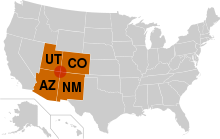
The 1993 Four Corners hantavirus outbreak was an outbreak of hantavirus that caused the first known human cases of hantavirus disease in the United States. It occurred within the Four Corners region – the geographic intersection of the U.S. states of Utah, Colorado, New Mexico, and Arizona – of the Southwestern United States in mid-1993. This region is largely occupied by Native American tribal lands, including the Hopi, Ute, Zuni, and Navajo reservations, from which many of the cases were reported.
The virus killed 13 people – half of those it infected, for a mortality rate of 50%.[1][2]
The cause of the outbreak was found to be a previously unknown species of hantavirus, which was responsible for a new form of illness known as hantavirus pulmonary syndrome (HPS). The virus is carried by deer mice. Originally referred to as "Navajo flu", "Four Corners virus", "Muerto Canyon virus", and "Convict Creek virus",[3] it was later named Sin Nombre virus. Transmission to humans was found to have occurred through contact with aerosolized deer mice droppings in enclosed spaces in and around the homes of the victims.
- ^ "The virus that rocked the Four Corners reemerges". aaas.org. 1 August 2013. Retrieved 15 May 2020.
- ^ "Hantavirus - Outbreaks". hantawatch. Retrieved 15 May 2020.
- ^ Hjelle, B. et al., "Emergence of Hantaviral Disease in the Southwestern United States," Western Journal of Medicine, 1994 161 (5): 467–473.